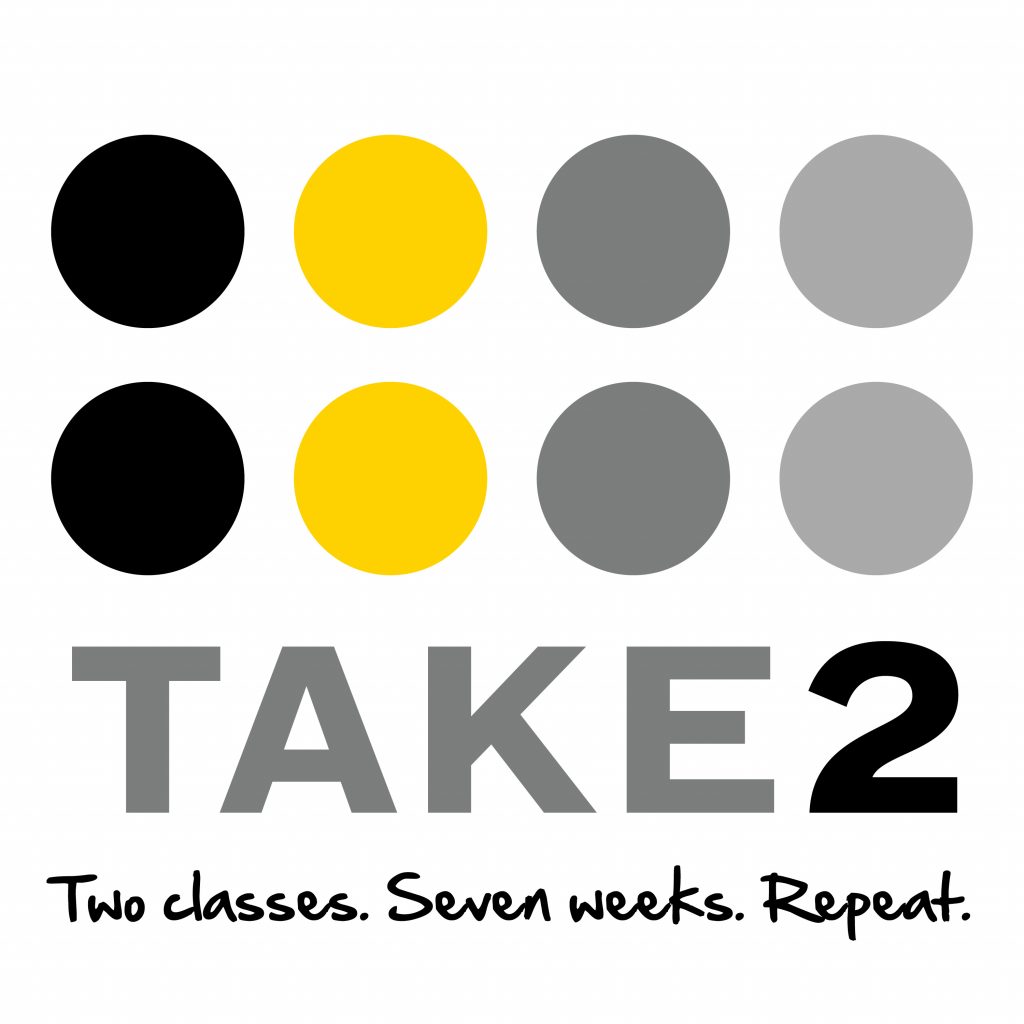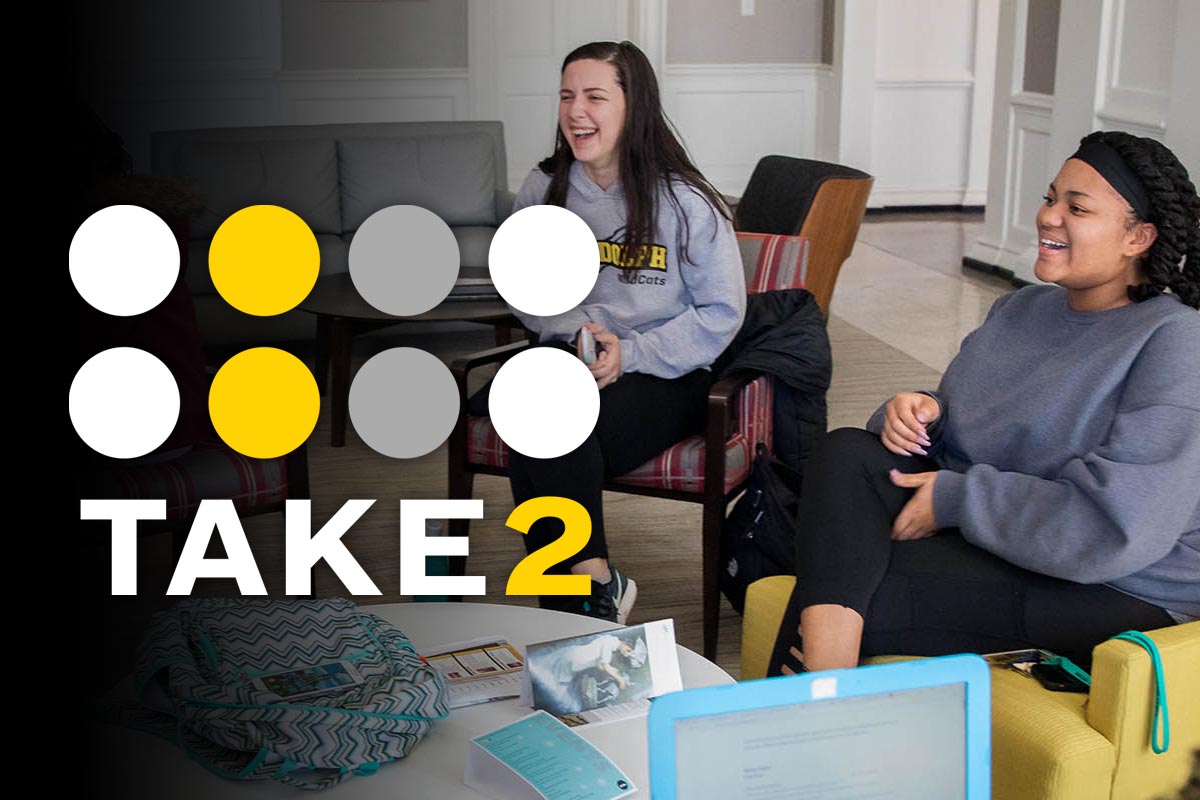TAKE2: One-of-a-kind academic model will better meet the needs of today’s students

Learn more abour Randolph College’s TAKE2 Academic Model at www.randolphcollege.edu/take2
At any number of colleges across the United States, students wake up each Monday prepared to spend their days juggling four or five classes, sports, clubs, jobs, friends, and more. And while the majority of students are able to be successful under this academic model, the amount of attention and time they can focus on each course is limited, especially when trying to pursue other interests and passions.
“Our faculty decided to ask why is this the system everyone in higher education uses?” said Gary Dop, an English professor. “And what if we decided to build our curricular model based on something that would allow our students to thrive?”
So a committee of faculty set out to find answers. After exploring how several schools across the country handle block scheduling, specifically four-course models, the faculty members decided to recommend a new take on the system, with a program that has students taking two classes at a time for seven-week sessions. Each semester will consist of two of these sessions separated by a one-week break.
While the students will ultimately be taking the same number of courses in an academic year, the new schedule will allow them to narrow their focus to just two at a time, rather than spreading their attention across four or five classes each week.
“We looked at the strengths of schools that emphasize immersion and interdisciplinary learning, and then we took the best of those, added our own innovations, and fused them all into one program,” said Dop, who co-chaired the committee.
After nearly two years of research, work, and planning, TAKE2 was born. Set to begin in fall 2021, the new curriculum is unlike any other in the country, and Randolph faculty believe it will revolutionize the way smaller, liberal arts schools approach learning—and most importantly, provide Randolph’s students with an education that better meets their needs.
“The traditional fall and spring semester system is what we all use because it’s the way it’s always been done,” said Amanda Rumore, a biology professor and member of the TAKE implementation committee. “But I don’t think there is a lot of data that suggests it’s what is best for students. You’re asking more and more of students in the same time period, with fewer resources to support them.”
Under Randolph’s new plan, students will not only have a more intensive academic experience, but the schedule allows more time for students to both explore newly discovered passions and conquer particularly difficult concepts. And because classes meet more frequently, students are less likely to fall behind.
“Students will begin to focus on their classes in a way they couldn’t before,” said Jesse Kern, a chemistry professor and member of the committee. “They won’t have to juggle five sets of deadlines. Maybe they get to focus on their Spanish vocabulary lessons and topics in environmental issues, without adding economics, Shakespeare, and German history on top of it. Plus, when they love a course, they can immerse themselves in it. If they struggle with a course, well, I think we can all tolerate just about anything for seven weeks.”
Professors are quick to point out that the new curriculum model is not easier. It just fits better with the learning styles of 21st century students. Courses will go from three-credit to four-credit and will meet up to four times a week, depending on the course. No classes will be held on Wednesdays. Exams will be held over 2.5 days, and Randolph will uphold the longstanding tradition of self-proctored exams.
“Students will still engage in the same amount of learning opportunities over the course of a year with the same expectations,” Dop said. “But we believe a student will learn better if each of those courses is taken over a shorter amount of time with fewer additional courses taken at the same time. In this model, students will have access to professors who are teaching no more than two courses and to a support team focused on helping the student be successful and get the most out of their college education. This is an experience that sets students up to thrive.”
TAKE2 allows for students to make connections between courses that might not have been available before, a benefit that excites faculty members.
“A student taking my creative writing course might be also taking a physics course,” Dop said. “So inevitably, their mind is going to be on physics when they sit down to write a poem. And we’ll be able to encourage them to walk that route. I might say, ‘Hey, whatever other class you’re doing needs to influence this next assignment. Surprise me with how you do that.’
“That to me, is how the connections will happen, organically and inorganically,” he added. “You don’t always have that when you are taking five courses.”
The narrowed focus is also going to better prepare students for today’s world, Rumore added.
“I don’t think it’s going to change the way they learn the material,” she said. “But it’s going to give them structure in their daily lives that’s going to be more like what they experience when they graduate.”
Another major benefit is the flexibility the new schedule offers students.
“It’s a model I think many students will be interested in because of its novelty and also because it’s designed to meet the students’ needs,” said Peggy Schimmoeller, an education professor and member of the TAKE2 committee. “It’s designed around the way this generation learns, and it opens up opportunities for them to do things outside of class, like take field trips or explore internships.”
Because classes meet more often, professors will be able to integrate learning techniques that might not have been possible with a regular classroom. In addition, students will have more time to explore other interests and activities, such as athletics, theatre, dance, art, internships, even jobs and community service.
“There’s a shift in higher education, and we can’t keep delivering the same format in the same way. The delivery system has to change to fit where the students are coming from,” Rumore said. “They are not just traditional students. We have more commuter students. They are also more involved. Our students have internships, work, athletics, and other activities. I haven’t come across one student not involved in one or two more things outside of class. Now they will have more time to balance their academic work without having to pick and choose what they give their attention to.”
Faculty members have spent the past year reworking and refining schedules and courses and advising current students about the new TAKE2 curriculum.
“TAKE2 takes advantage of our greatest strength as a small liberal arts college for whom access to faculty is a hallmark—and nationally recognized as a hallmark,” said Carl Girelli, provost. “What better way to capitalize fully on that access to faculty than by having more intense, deeper relationships around discussions and important conversations about things that matter. It capitalizes on our understanding of students, and it capitalizes on our strengths as teachers.”
One of the biggest priorities is making sure current students are able to graduate on time.
Academic advisors are working closely with students to plan out their schedules for the coming years so they can seamlessly transition into the TAKE2 program this fall. They do not anticipate students having issues getting the classes they need to graduate. In fact, because the courses are changing to four credits, some students may find themselves eligible to graduate early.
“There’s always anxiety when there is change,” Schimmoeller said. “But sometimes you have to go beyond what is comfortable to find better solutions. We believe this is a model that will work for Randolph and our students. And we believe we are going to see significant benefits, not only with increased enrollment, but also with our student achievement.”
TAKE2 is a chance for Randolph to showcase its strengths while standing out among other small, liberal arts colleges, faculty said.
“I’m incredibly proud of our faculty for being willing to try something that no one else is trying, something that is spectacular and innovative,” Dop said. “It illustrates how a small college can lead. And more importantly, it shows where our focus is. Every student’s journey matters here. We care deeply about each individual student and what their experience will be and whether their needs are met.”
Learn more abour Randolph College’s TAKE2 Academic Model at www.randolphcollege.edu/take2
Tags: TAKE2, Vita No. 10

